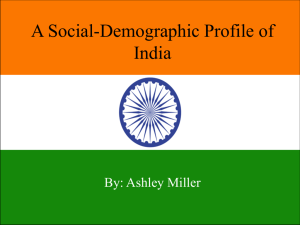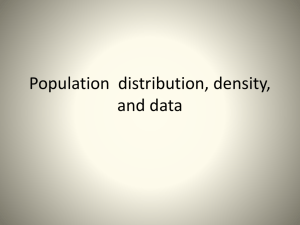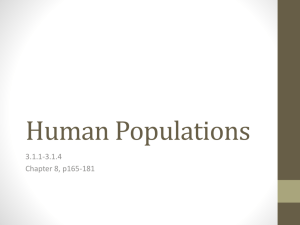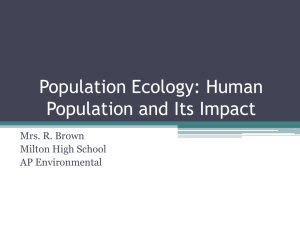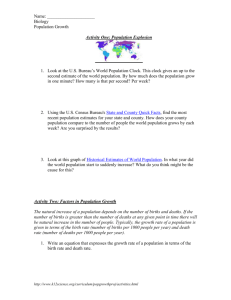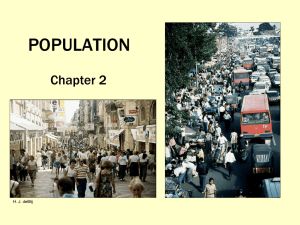II. Population Parameters and Processes 1. Total Fertility Rate a. At
advertisement
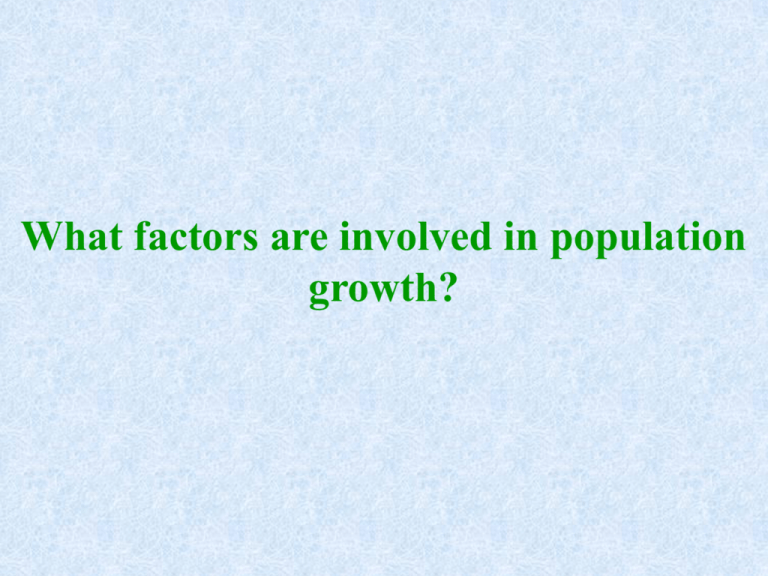
What factors are involved in population growth? II. Population Parameters and Processes A. Important Demographic Statistics 1. Total Fertility Rate a. At least a rate of 2.1 births is needed to replace population – WHY ? b. The more developed a region the less fertility rates will be c. The more education a women receives the lower fertility rates will be. d. Religious and cultural issues also can play a role. Secondary school enrollement (Ratio of students enrolled in secondary school to secondary school-age population) 120 100 Percentage Based on the graphs predict the total fertility rate 80 Boys Girls 60 40 20 0 World -- rank the regions from highest to lowest. Latin America & the Caribbean Africa Asia More Developed Countries Less Developed Countries Region Adult Literacy (percentage of men and women who arel literate, age 15+) 100 90 80 Percent 70 60 Men 50 Women 40 30 20 10 0 World Latin America & the Caribbean Africa Asia Less Developed Countries Age at first marriage and teenage childbearing 80 73 70 Percent 60 50 Percentage of Women 20-24 who were married before age 18 40 Percentage of women 15-19 giving birth each year 31 30 24 20 15 11 10 9 10 5 0 United States Brazil Zimbabwe Bangladesh What countries (3) have the highest female literacy? TFR? 2. Infant Mortality Rates Lowest Infant Mortality Rate (deaths per 1,000 births): 2004 Highest Infant Mortality Rate (deaths per 1,000 births): 2004 1. Singapore 2.28 208 Angola 192.5 2. Sweden 2.77 207 Afghanistan 165.96 3. Japan 3.28 206 Sierra Leone 145.24 4. Iceland 3.31 205 Mozambique 137.08 5. Finland 3.59 204 Liberia 130.51 6. Norway 3.73 203 Niger 122.66 7. Malta 3.94 202 Somalia 118.52 8. Czech Republic 3.97 201 Mali 117.99 9 Andorra 4.05 200 Tajikistan 112.10 10 Germany 4.20 199 Guinea-Bissau 108.72 36 United States 6.5 What regions have the highest and lowest Infant Mortality? 3. Life Expectancy a. Major factors that affect L.E. are violence, poor health care, epidemic disease, and famine. b. 1950s, only five countries in the world had a life expectancy over 70 years --- Today some 60 countries outside of North America and Europe have life expectancy over 70 (none in Sub-Saharan Africa) What regions have the highest and lowest Life c. AIDS – 36 Expectancy million HIV positive and 95% of them live in developing nations 4. Crude Birth Rate (CBR) 5. Crude Death Rate (CDR) 6. Natural Increase Rate (NIR) a. Negative = more deaths than births b. Positive = more births than deaths c. Some Regions are showing negative growth - Europe for example What regions have the highest and lowest Natural Increase Rate d. Factors that affect natural increase 1) Economic development – Higher economic development = lower NIR 2) Education affects – Higher education = lower NIR 3) Gender empowerment – Countries w/ women who have more economic and political access, power, and education = lower NIR 4) Health care – better health, lower infant mortality = higher NIR --- but --- better health care also means more access to contraception = lower NIR 5) Cultural traditions – cultures can encourage high birth rates or limit opportunities outside the home, by elevating mother hood to a high position or discouraging the use of birth control = higher NIR 6) Public Policy - Example: China's one child policy creates economic incentives and legal penalties related to the number of children born – In Japan births encouraged B. Demographic Accounting Equation - formula used to predict how population will grow. 1. Start with population now and then, subtract the number of deaths, add immigration, and subtract emigration. 2. Because of all the potential factors that can affect population growth and variables can change over time making it harder to predict growth 3. Example of Population Projection P (t + 1) = P (t) + B (t, t + 1) - D (t, t + 1) (Natural Change) + I (t, t + 1) - E (t, t + 1) (Net Migration) Where P = population B = births D = deaths I = immigration E = emigration t = time now t + 1 = some time in the future

